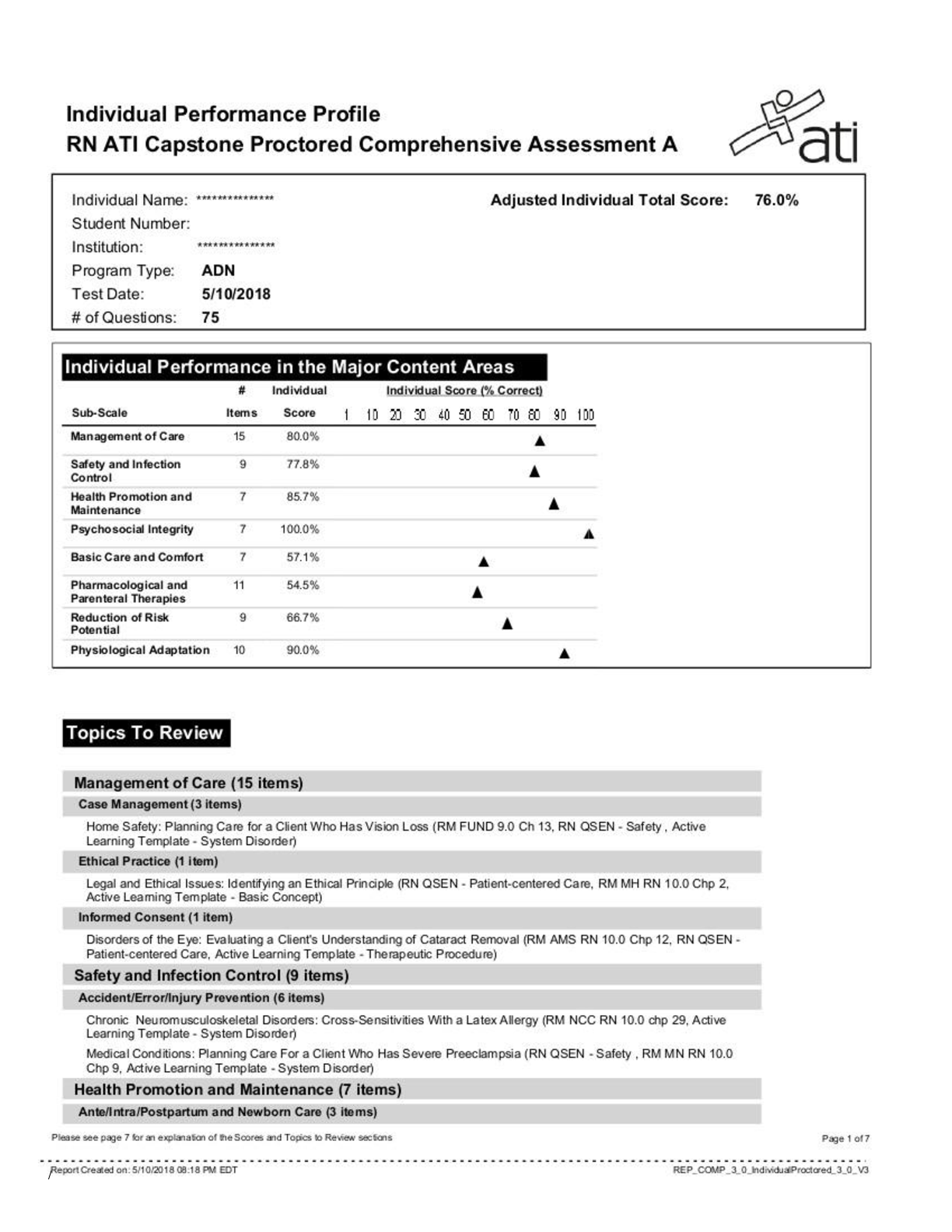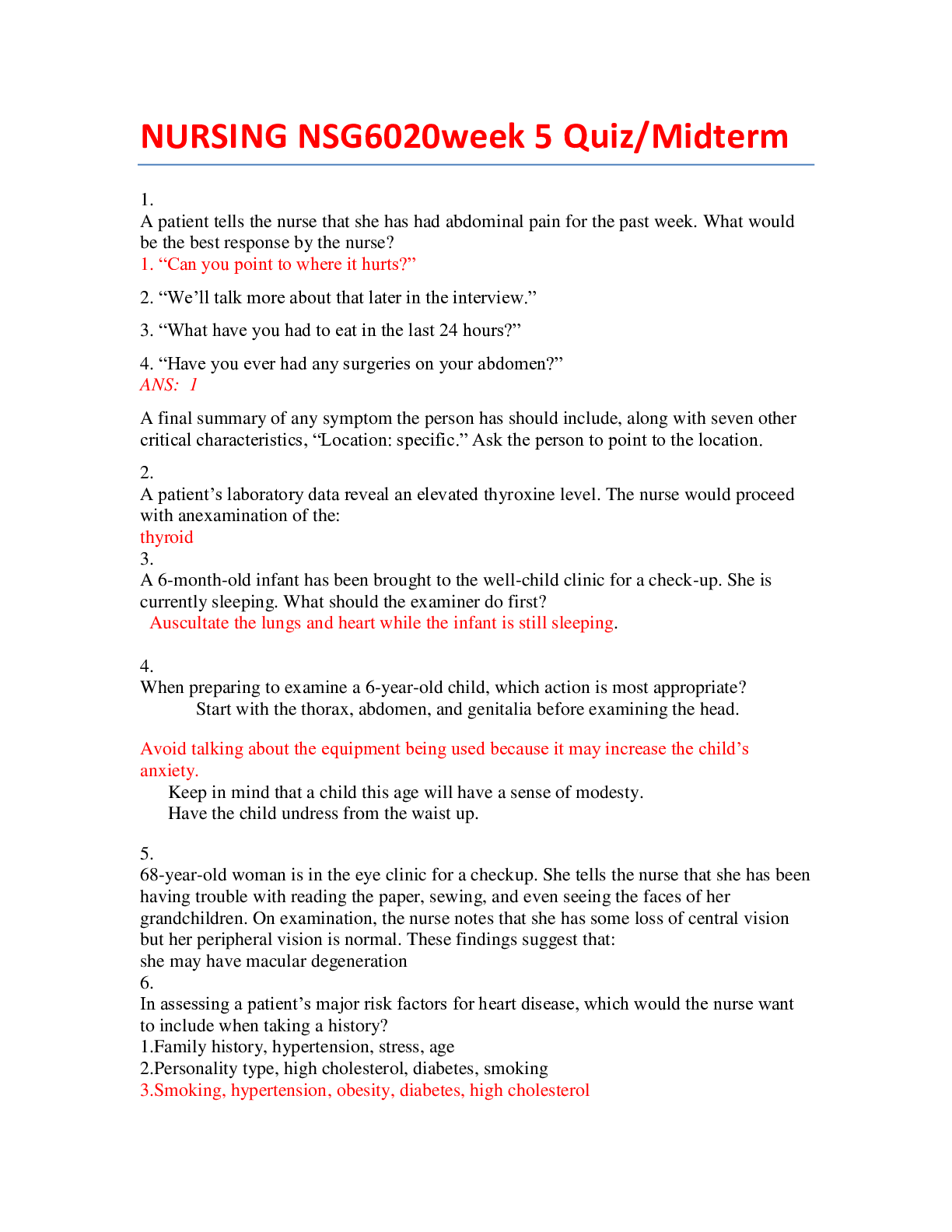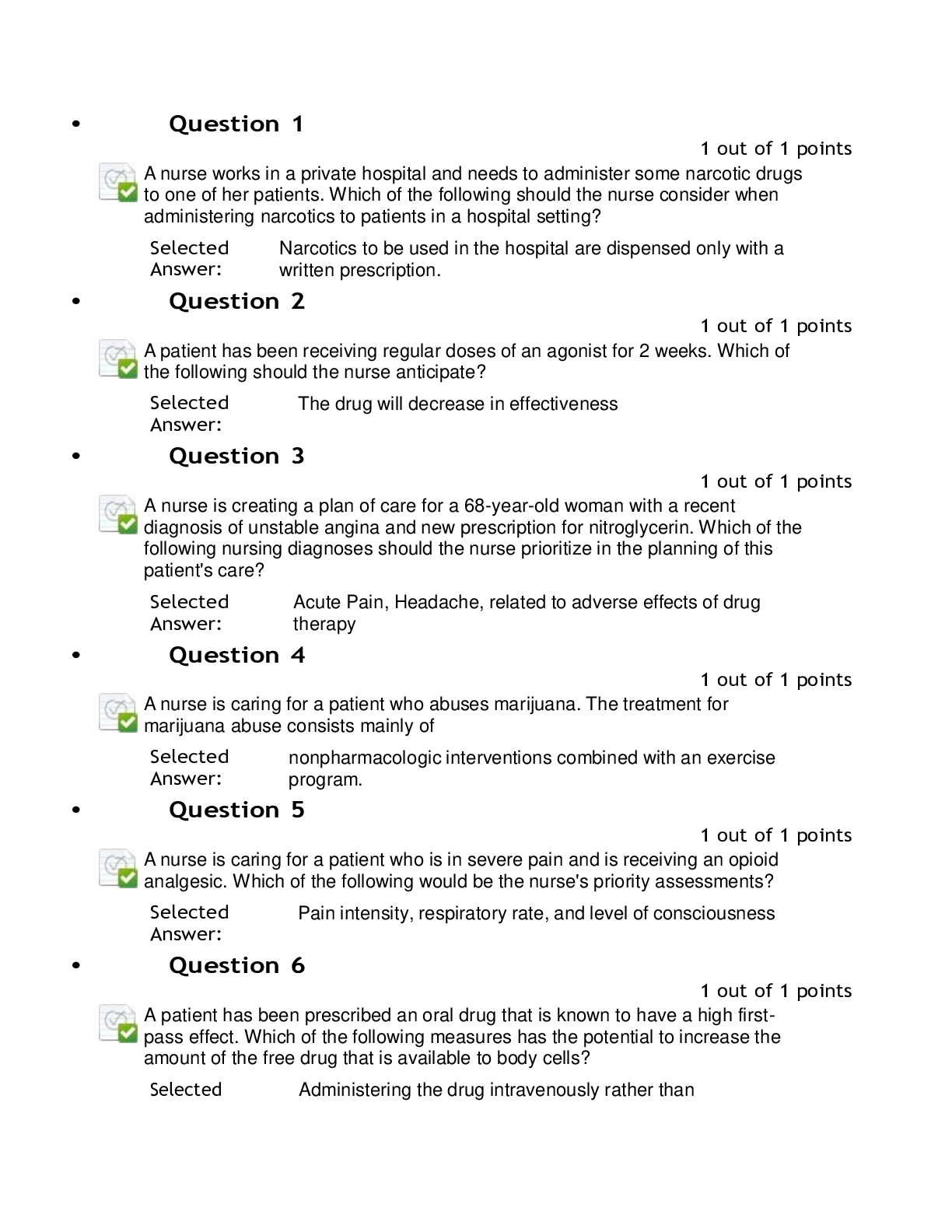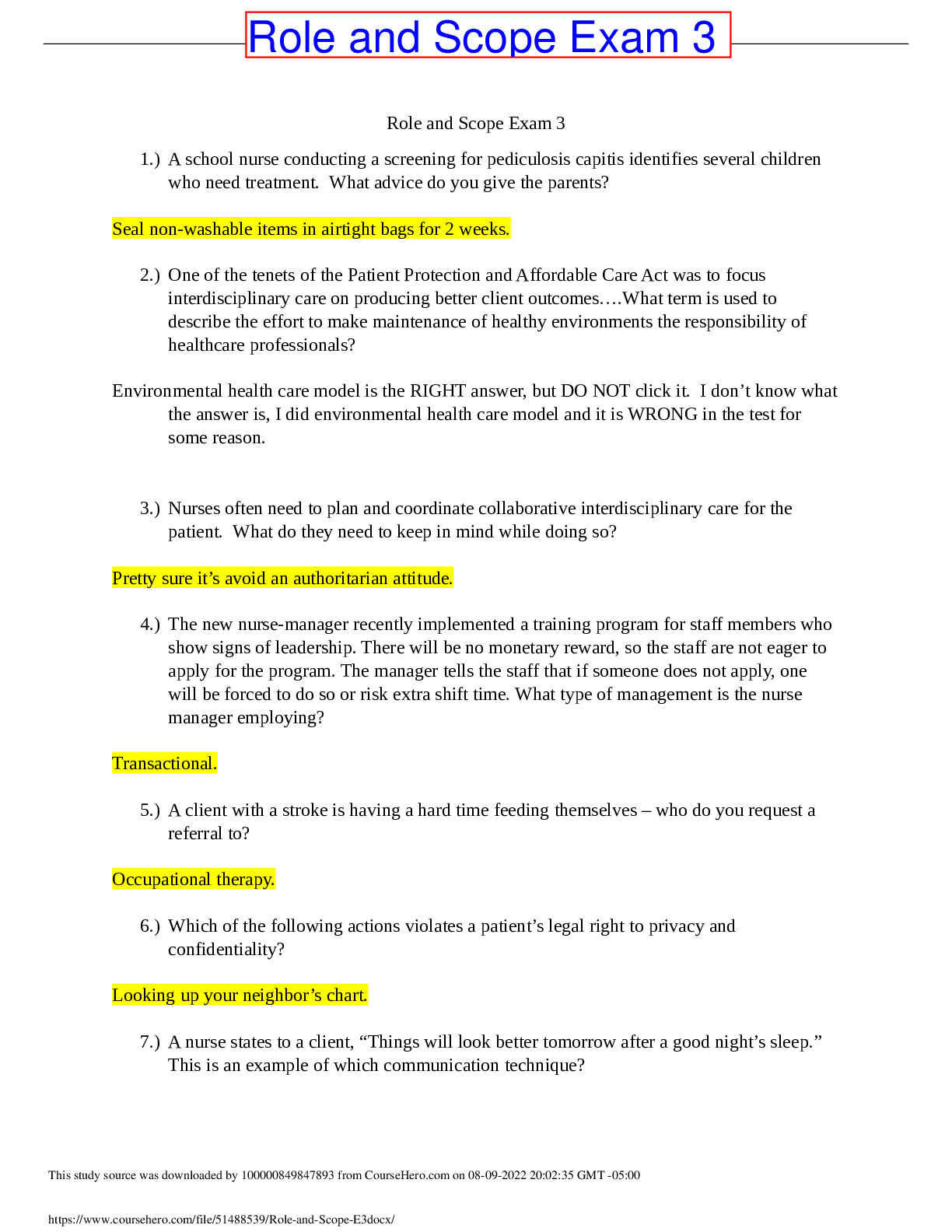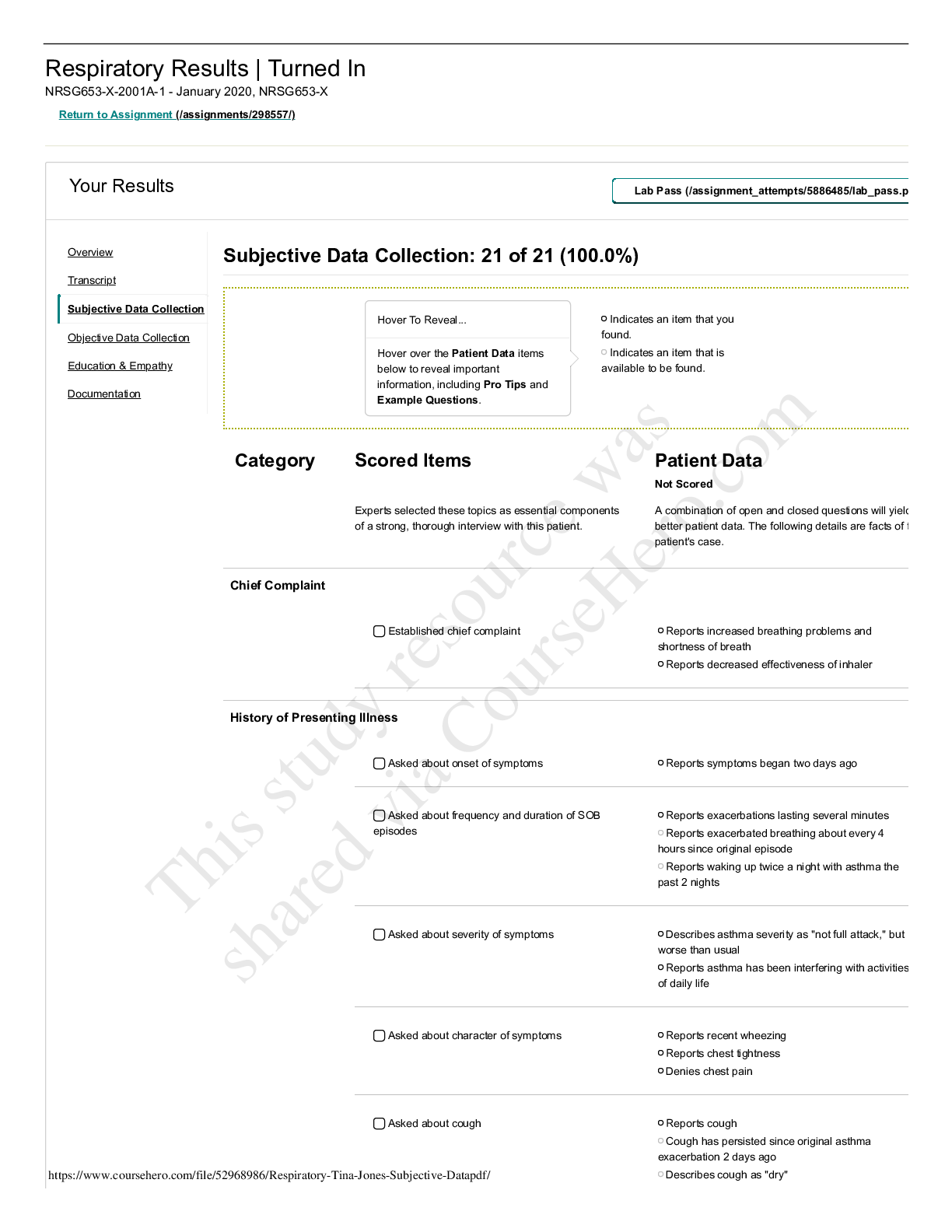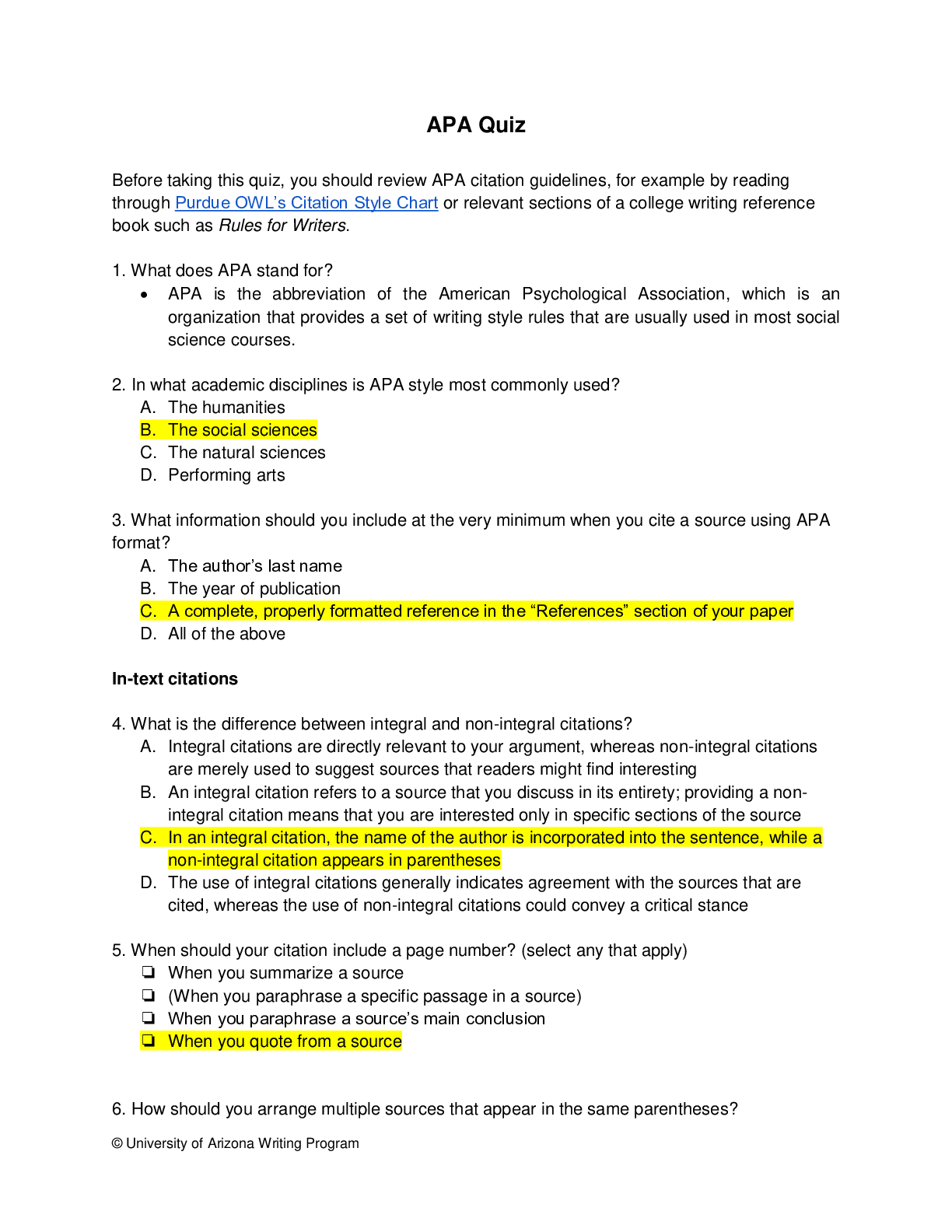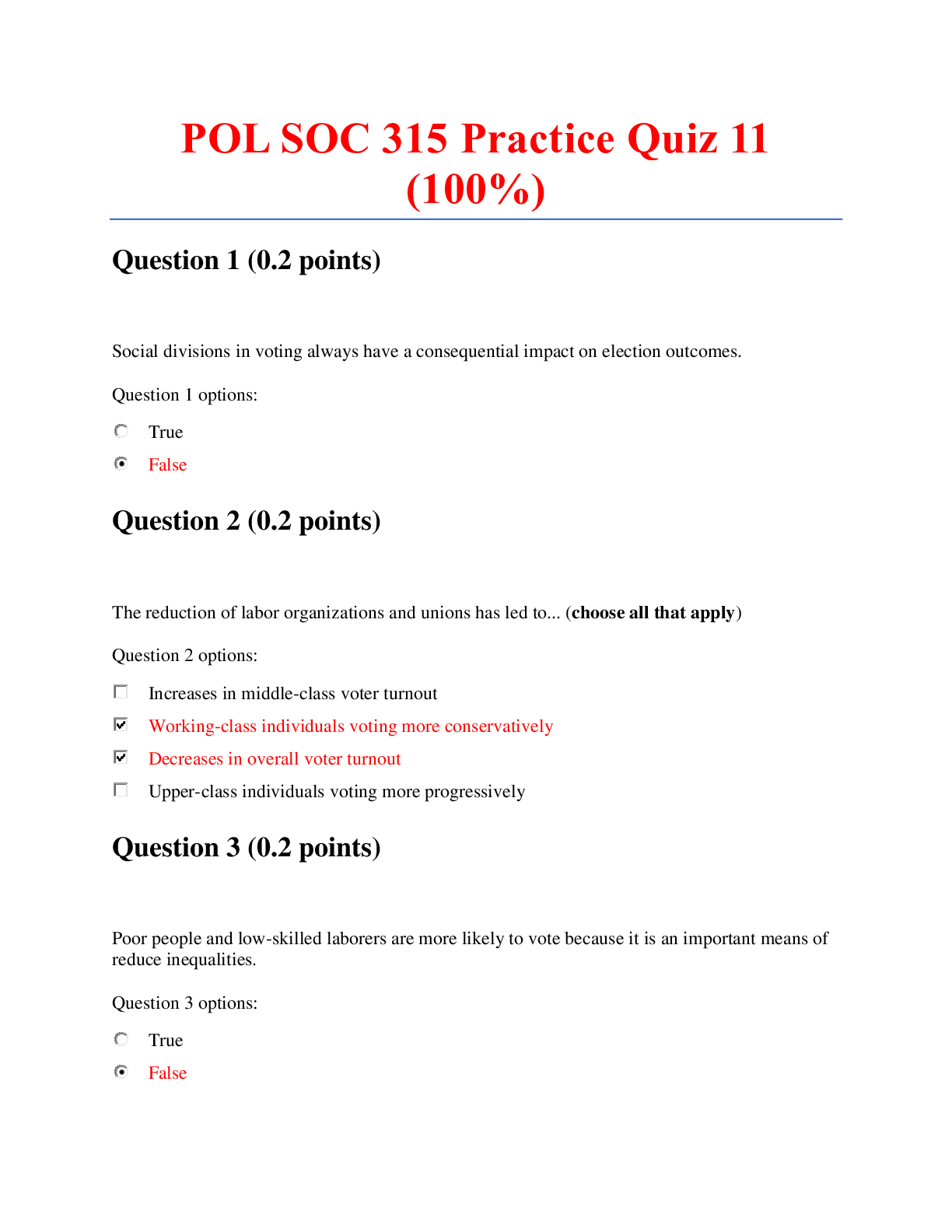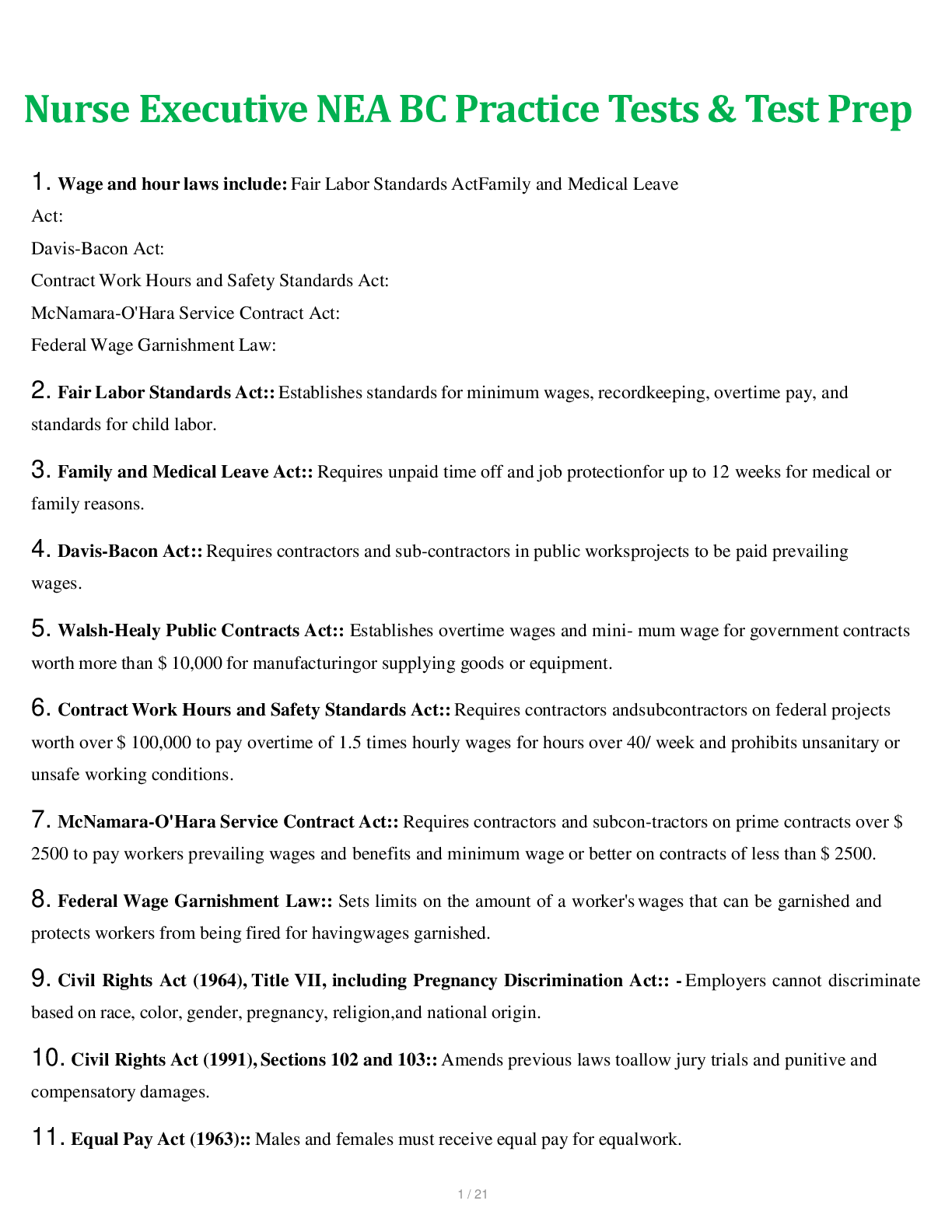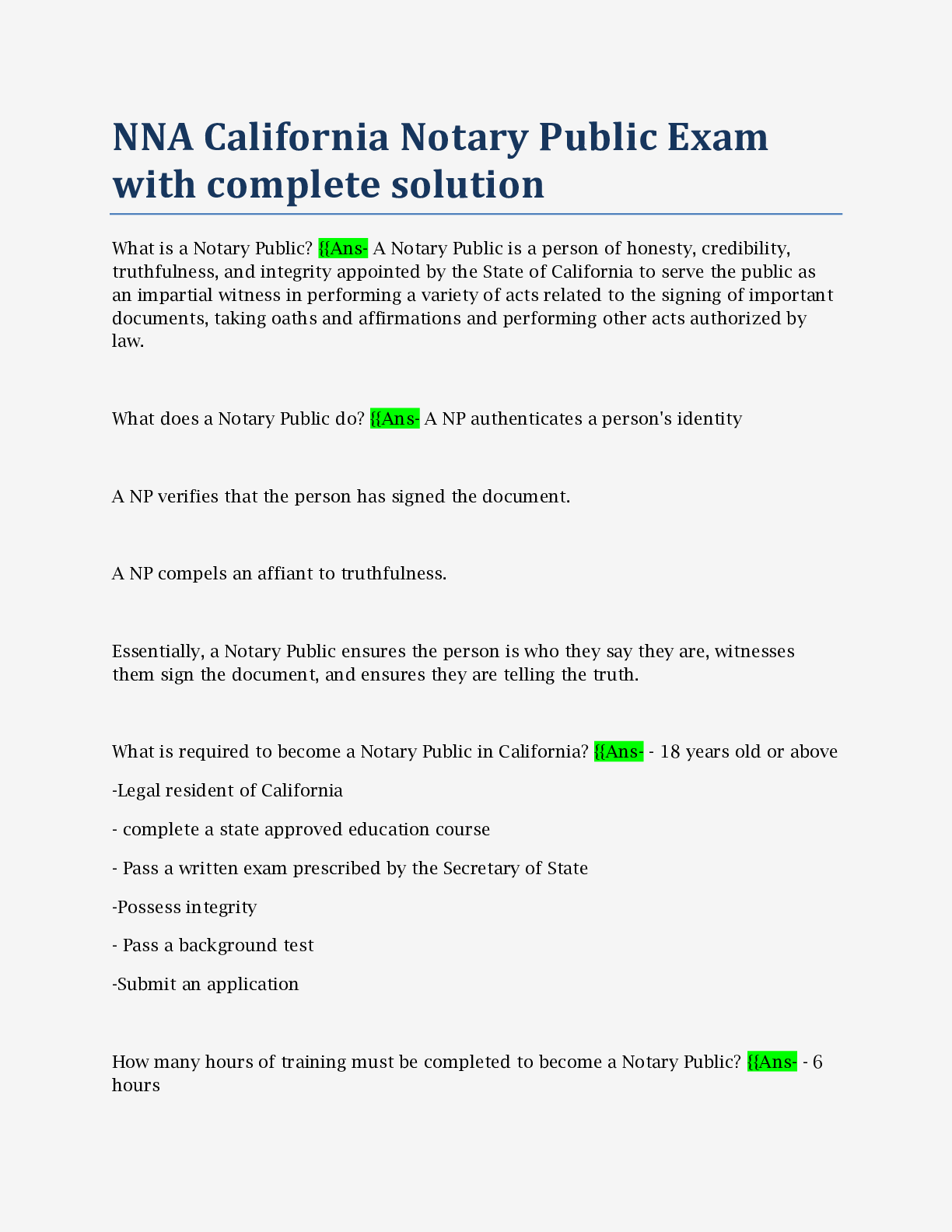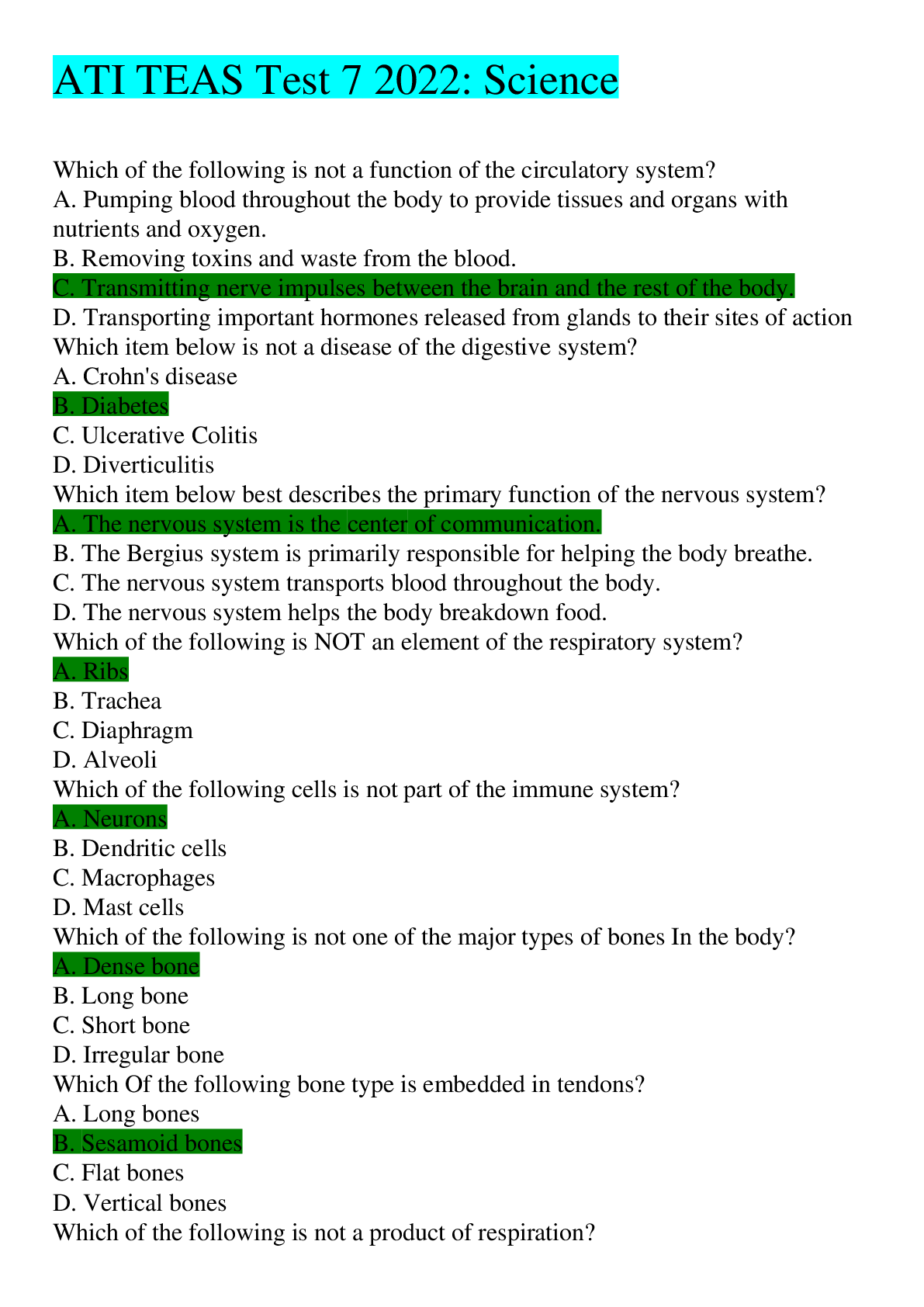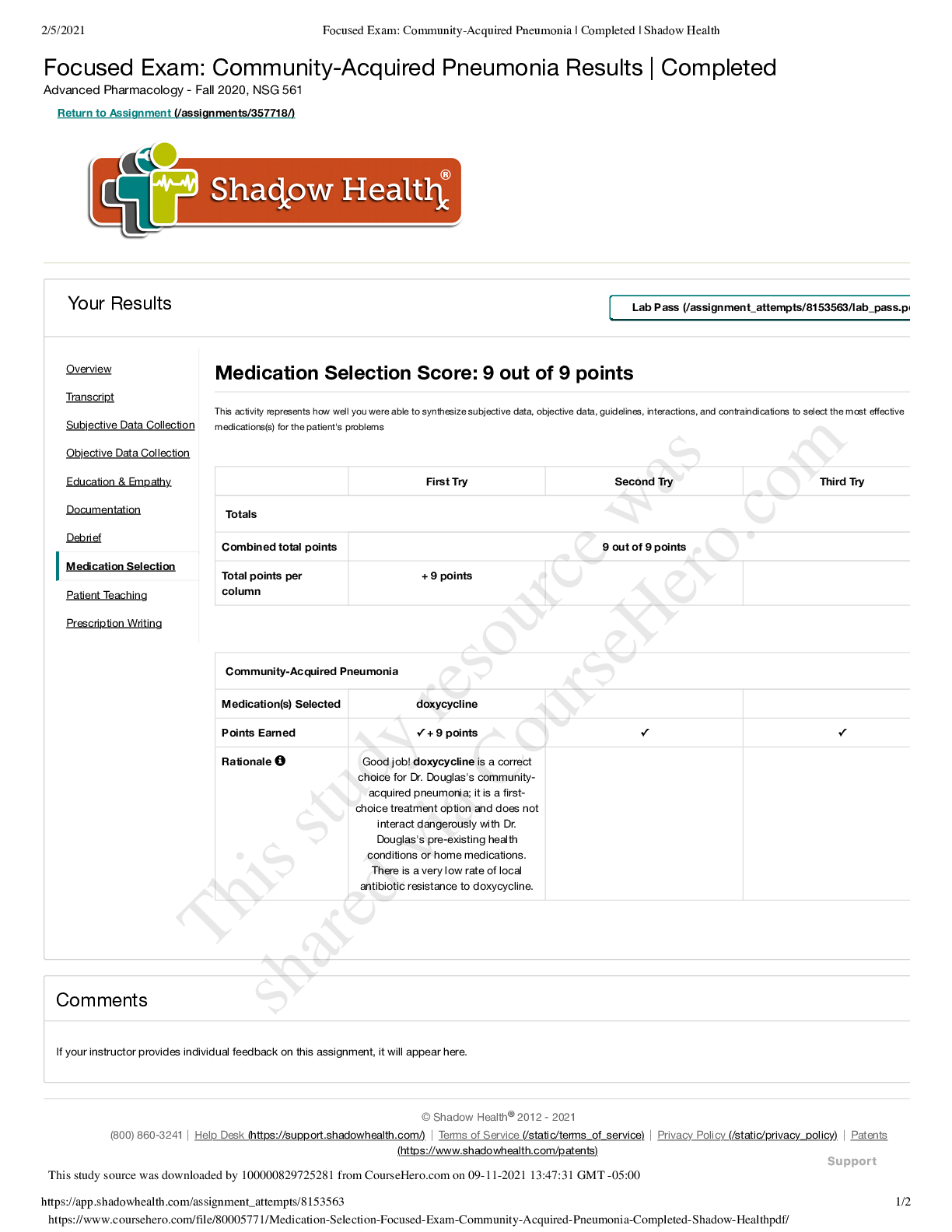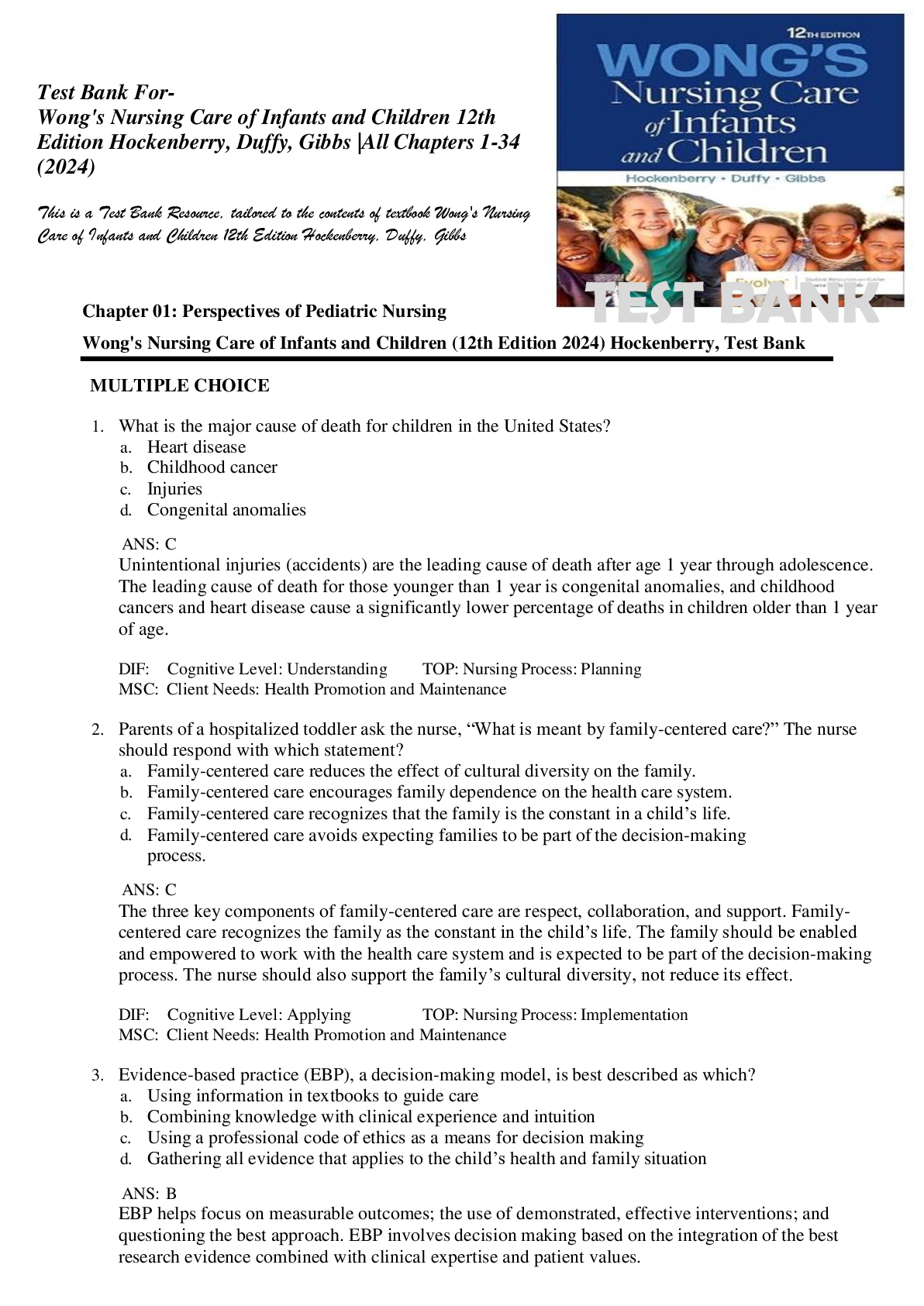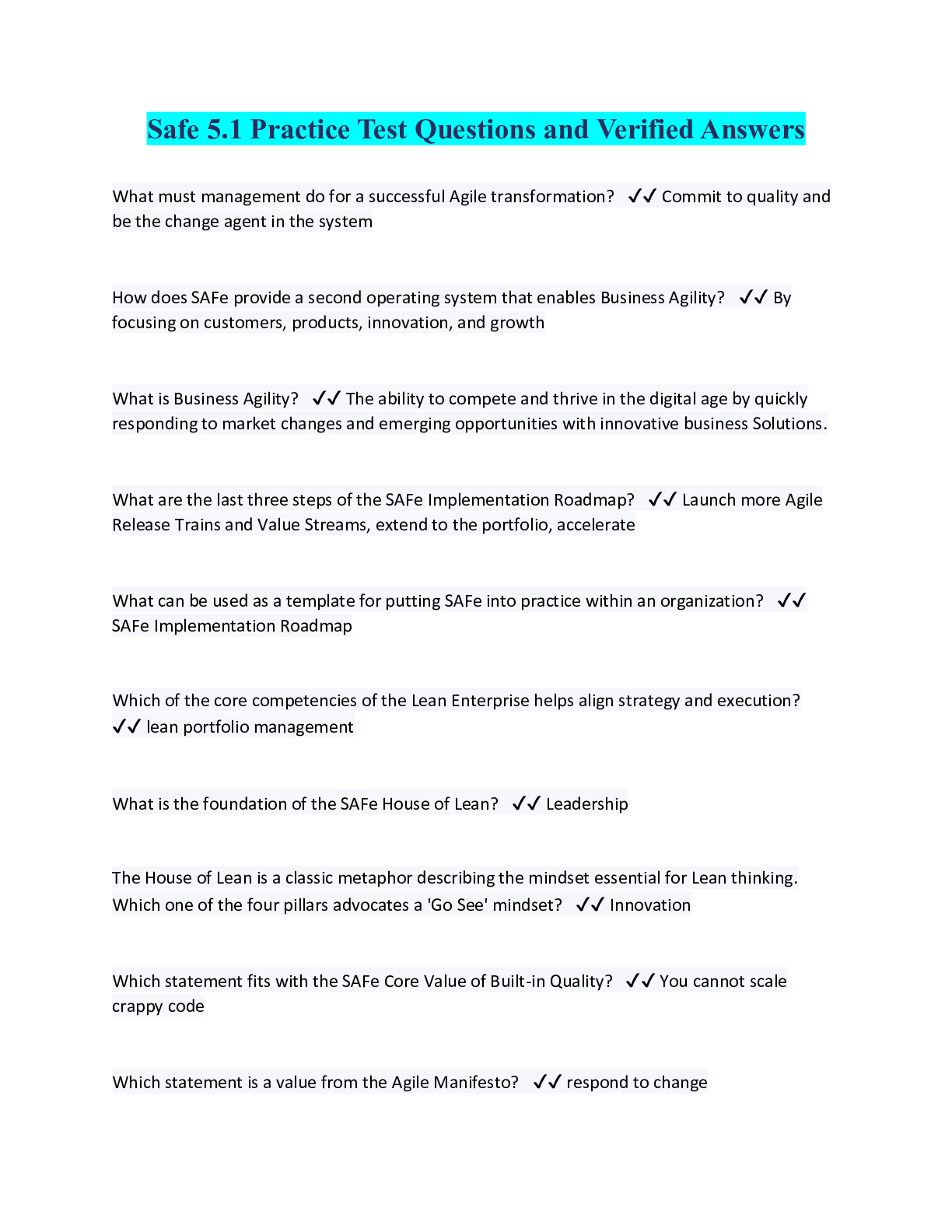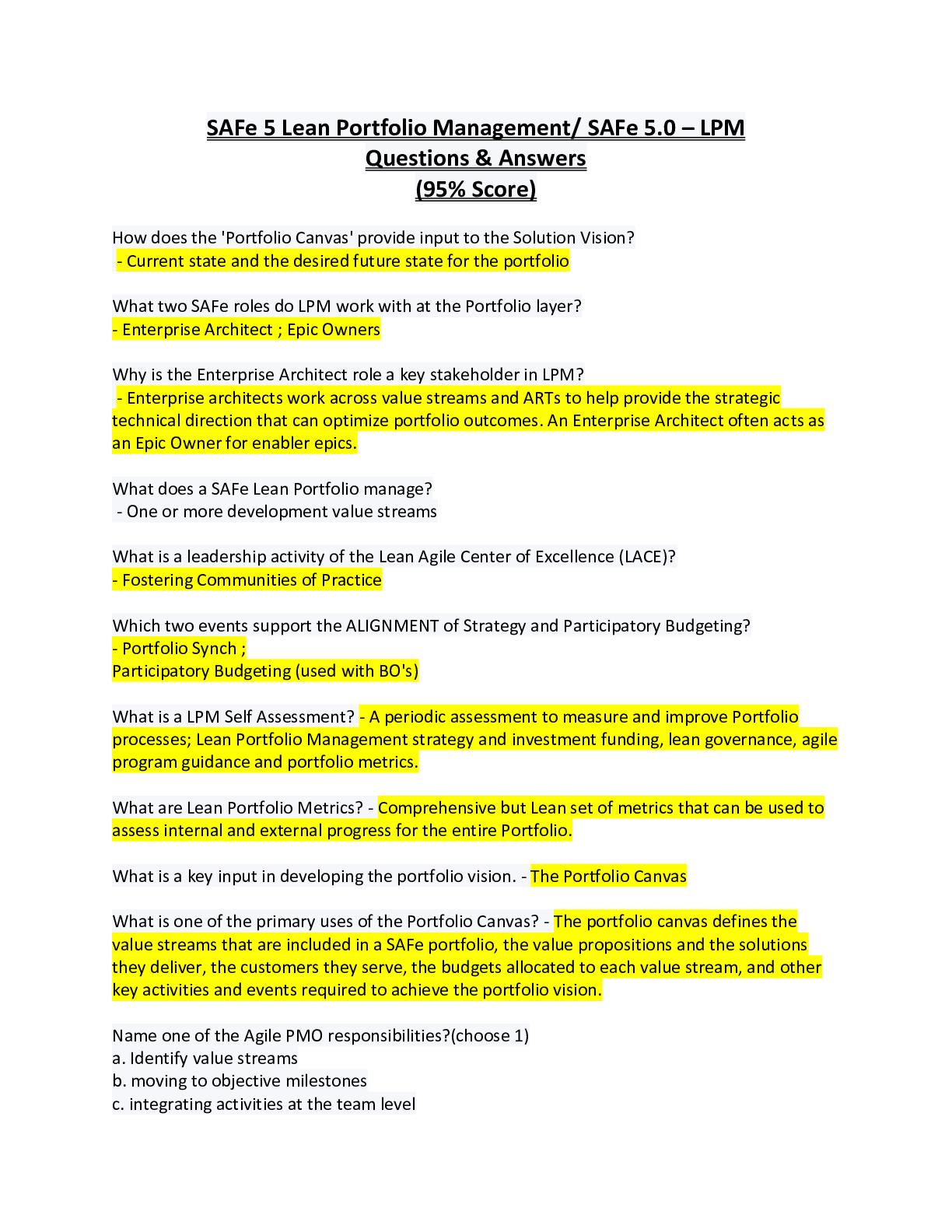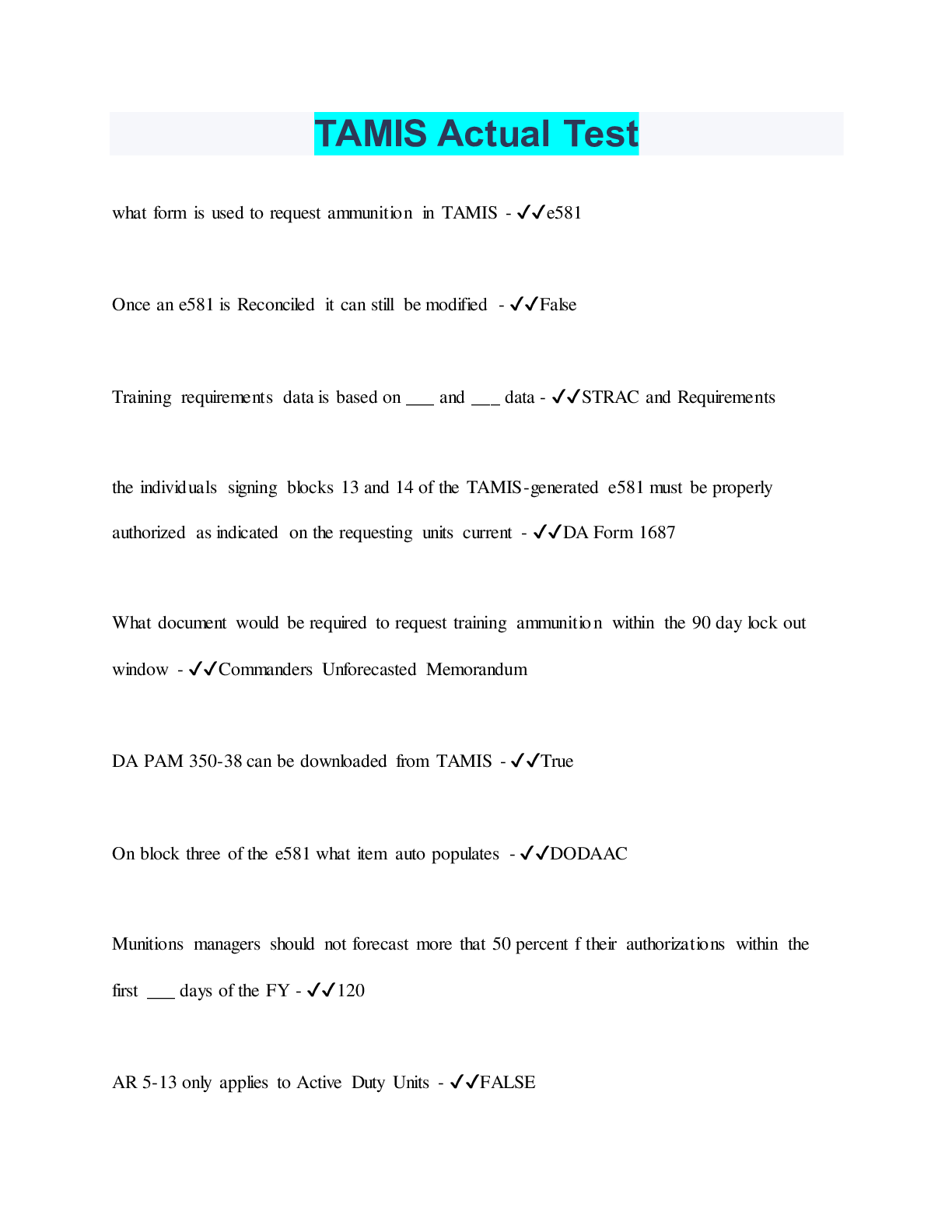Health Care > EXAM > Arizona State University. Global Healthcare System HCD 303. HCD 303 Final Exam. Fall 2019 Session C (All)
Arizona State University. Global Healthcare System HCD 303. HCD 303 Final Exam. Fall 2019 Session C Final Exam. Great Last Minute Exam Prep. Contain 100 Questions and Answer,
Document Content and Description Below
HCD 303: Global Healthcare Systems Professor White: Fall 2019 Session C Final Exam HERE IS A LIST OF THE QUESTIONS Question 1 2 / 2 pts Why is it important to study the healthcare systems of oth... er nations around the world? To gain a sense of what types of models are being utilized by various countries and the subsequent outcomes of those healthcare models To analyze how other systems are structured, financed and what barriers they are facing Learn about innovations in care delivery taking place in other countries To gain a general sense of what types of models, system designs, and innovations are working well, and which are not to eventually improve the US healthcare systemCorrect! All of the above are valid reasons to study global healthcare system Question 2 2 / 2 pts How does the US healthcare system perform overall? Correct Answer There is high variance in quality, cost, and access throughout the country The US is #1 Generally speaking, there is consistent performance across the nation in terms of quality, cost, and access The life expectancy is the US is longer than anywhere else in the world so that speaks highly to the high quality of its healthcare systemYou Answered None of these are accurate statements of how the US healthcare system performs overall Question 3 2 / 2 pts Select the best choice that properly defines a system? A set of connected things or parts forming a complex whole A series of events, procedures, or interactions that produces an outcome A set of principles or procedures to which something is organizedorrect! All of the above None of these Question 4 2 / 2 pts Which of the following is the ultimate goal of a healthcare system? Provide the best quality of care to patients regardless of costorrect! Provide universal access to high quality, affordable healthcare To make as much money as possible as it a major driving force of a nation’s economy Provide high quality, affordable healthcare to those who happen to have health insurance Stuvia.com - The Marketplace to Buy and Sell your Study Material Stuvia.com - The Marketplace to Buy and Sell your Study Material Treat patients to the best of our ability, given the current restraints placed upon us by the healthcare system Question 5 2 / 2 pts What is meant by the term universal coverage? Refers to the area of healthcare that ensures that services such as hospitals and clinics are in every city, state, or region within a country. When individuals with health insurance are covered for all the healthcare services they will need in their lifetime. When everyone across the world, regardless of individual circumstance, has access to healthcare insuranceorrect! All citizens within a country have access to healthcare insurance, regardless of individual circumstance It is a term synonymous with socialized medicine as you can only achieve universal coverage through socialized medicine models Question 6 2 / 2 pts Select the nation listed below that does NOT provide universal access to healthcare The United Kingdom Singapore Canadaorrect! The United States Germany Question 7 2 / 2 pts What is globalization? It is the transfer of diseases from one country to the next and is also known as global healthCorrect! The interaction and integration among the people, companies, and government of different nations The interaction and integration among the people, companies, and government of the different states within the USA The act of thinking about a problem and ultimately developing a solution from a 360 degree view A term used to describe that individuals with health insurance are covered for all the healthcare services they will need in their lifetime Question 8 2 / 2 pts Which of the following is NOT an example of globalization that we see in healthcare today? A patient coming from Wisconsin to Mayo Clinic in Phoenix, AZ to receive care Stuvia.com - The Marketplace to Buy and Sell your Study Material Travelling to the Cuba to receive a knee replacement at a lower cost Immigrating to the United States from a different country to work as a caregiver in a nursing homeou Answered Driving to Mexico to refill a prescription An American provider moving to the United Kingdom to work in a local hospital Question 9 2 / 2 pts In class we discussed 3 landmark studies that have been done to compare and rank healthcare systems around the world. Given the results of these studies, which of the following statements is correct The World Health Organization ranked the U.S healthcare system 37th overall, which was better than any country that utilized the Beveridge Model The Bloomberg Business Report ranked the U.S. healthcare system 50th overall, which was better than any country that utilized the Bismark Model The Commonwealth Fund ranked the U.S. healthcare system 11th overall, which was the best the United States has ever performed on an international healthcare rankingCorrect! The U.S. performed consistently poor on all 3 rankings – which are difficult to compare since they utilized different measures of success and analyzed varying numbers of countries overall. None of these are correct Question 10 2 / 2 pts Which of the following would NOT be an effective measure of the overall quality of a healthcare system? Patient mortality rates for specific conditions such as coronary artery disease Rates of hospital inquired infectionsorrect! Patient insurance status such as insured or uninsured Patient satisfaction rates such as HCAHPS scores Readmission rates for heart failure Question 11 2 / 2 pts Which of the following would NOT be an effective measure of overall access within a healthcare system? Patient insurance status such as insured or uninsured Rates of patients considered to be underinsured Correct! Patient satisfaction rates such as HCAHPS scores Proximity of necessary healthcare services to a patient’s hom Provider to patient ratios in a population Question 12 Stuvia.com - The Marketplace to Buy and Sell your Study Material 2 / 2 pts Which of the following would NOT be an effective measure of the overall cost of a healthcare system?Correct! Patient’s tax bracket as those with lower socio-economic status have higher rates of being uninsured Healthcare spending as a percentage of the gross domestic product (GDP) Patient’s out-of-pocket spending for healthcare services including copayments and deductibles Overall healthcare spending per capita Cost per procedure such as a knee or hip replacement Question 13 2 / 2 pts Which are the 4 components of a healthcare system? Quality, cost, access, and life expectancy Correct! People, parts, inter-relationships, and culture Promises, prescriptions, paperless billing, and competencies People, parts, payers, and competencies Payers, Providers, Patients, and Hospitals Question 14 2 / 2 pts When referencing healthcare systems, the term centralized means: Regulations and oversight of the system is organized within the government at any level Correct! Regulations and oversight of the system is organized at the federal level Regulations and oversight of the system is organized among the CEOs of healthcare organizations Regulations and oversight of the system is left to the responsibility of individual regions or states The term centralized refers to the allocation of power within a system and that can vary from country to country so this term is fluid and could mean different things depending on the context Question 15 2 / 2 pts Select the country that has a healthcare system that is centralized in ALL aspects of their system (healthcare delivery & health insurance): Germany United States CanadaCorrect! United Kingdom Stuvia.com - The Marketplace to Buy and Sell your Study Material None of these Question 16 2 / 2 pts When referencing healthcare systems, the term decentralized means: Regulations and oversight of the system is organized within the government at any level Regulations and oversight of the system is organized at the federal level Regulations and oversight of the system is organized with the CEOs of healthcare organizations Correct! Regulations and oversight of the system is left to the responsibility of individual regions or states The term decentralized refers to the allocation of power within a system and that can vary from country to country so this term is fluid and could mean different things depending on the context Question 17 2 / 2 pts Select the country that has a healthcare system that is decentralized in ALL aspects of their system (healthcare delivery & health insurance):Correct! Germany United States Canada United Kingdom Singapore Question 18 2 / 2 pts What healthcare model is utilized in the United Kingdom? Bismarck model Beveridge model Out-of-pocket modelYou Answered National health insurance model Bevan model Question 19 2 / 2 pts What healthcare model is utilized in Germany?Correct! Bismarck model Beveridge model Out-of-pocket model National health insurance model Bevan model Question 20 Stuvia.com - The Marketplace to Buy and Sell your Study Material 2 / 2 pts What healthcare model is utilized in Singapore? Bismarck model Beveridge model Out-of-pocket modelCorrect! National health insurance model Bevan model Question 21 2 / 2 pts What healthcare model is utilized in the rural areas of Africa and South America?You A Bismarck model Beveridge model Out-of-pocket model National health insurance model Bevan model Question 22 2 / 2 pts Of the countries listed below, which utilizes the National Health Insurance Model? United Kingdom GermanyCorrect! Canada Cuba All of these use the national health insurance model Question 23 2 / 2 pts What are social programs as it pertains to healthcare?Correct! Programs that are provided by the government to help those less fortunate access health and healthcare services Programs where like people get together to discuss a unifying topic such as diabetes support groups Social platforms utilizing technology to connect people remotely such as Facebook or Instgram Programs developed to keep patients within the inpatient setting connected socially to the outside world Any program that promotes social engagement Question 24 2 / 2 pts Which populations does the Medicare program cover in the United States? Low socio-economic status, elderly, those with end-stage renal disease Stuvia.com - The Marketplace to Buy and Sell your Study Material Low socio-economic status, disabled, and pregnant woman Low socio-economic status, disabled, and elderly Low socio-economic status, pregnant woman, those who recently gave birth within the past 12 monthsCorrect! Elderly, Disabled, those with end-stage renal disease Question 25 2 / 2 pts Which of the following healthcare models best represents Medicare? Beveridge model Bismarck model Correct! National health insurance model Out-of-pocket model None of these are correct Question 26 2 / 2 pts Which of the following is covered by Medicare, Part A? Prescription medications Outpatient services and physician feesCorrect! Inpatient services such as a hospital stay Portion of Medicare that can be purchased separately to have insurance services provided by a private health insurance organization Medicare, part A is comprehensive and covers all of these services Question 27 2 / 2 pts Which of the following is covered by Medicare, Part B? Prescription medicationsCorrect! Outpatient services and physician fees Inpatient services such as a hospital stay Portion of Medicare that can be purchased separately to have insurance services provided by a private health insurance organizations None of these are correct Question 28 2 / 2 pts Which of the following is covered by Medicare, Part C? Prescription medications Outpatient services and physician fees Inpatient services such as a hospital stayCorrect! Stuvia.com - The Marketplace to Buy and Sell your Study Material Portion of Medicare that can be purchased separately to have insurance services provided by a private health insurance organization None of these are correct Question 29 2 / 2 pts Which of the following is covered by Medicare, Part D?Correct! Prescription medications Outpatient services and physician fees Inpatient services such as a hospital stay Portion of Medicare that can be purchased separately to have insurance services provided by a private health insurance organization None of these are correct Question 30 2 / 2 pts Which best describes the population that the Medicaid program covers in the United States? Low socio-economic status, elderly, those with end-stage renal disease Low socio-economic status, veteran's, and pregnant woman You Answered Low socio-economic status, disabled, and elderly Low socio-economic status, pregnant woman, those who recently gave birth within the past 12 months Elderly, Disabled, those with end-stage renal disease Question 31 2 / 2 pts Which of the following statements is true?Correct! Medicare is a centralized program meaning it is organized at the federal level Medicare is a decentralized program meaning it is organized at the state level Medicare is a decentralized program meaning it is organized at the federal level Medicaid is a centralized program meaning it is organized at the state level Medicaid is a decentralized program meaning it is organized at the federal level Question 32 2 / 2 pts What populations listed below would NOT be covered by both Medicare and Medicaid (dueleligible)? Those of low-income over the age of 65 years Those of low-income with end-stage renal diseaseCorrect! Those of low-income who are pregnant or had a child within the last year Those of low-income with a disability Individual's can only ever qualify for one program Stuvia.com - The Marketplace to Buy and Sell your Study Material Question 33 2 / 2 pts Which on the following would be considered a public healthcare entity? Any charitable organizations (501-C) Any non-profit organization Any for-profit organization Any organization or program that is run by the federal government onlyCorrect! Any organization or program that is run by any level of government Question 34 2 / 2 pts Which of the following programs is NOT a public program? Medicare in the United States! Sickness funds in Germany Medisave in Singapore Medicaid in the United States National Health Service (NHS) in the United Kingdom Question 35 2 / 2 pts Which of the following patient populations/programs from the United States would best resemble the Beveridge model? Average US worker, employed full time Medicare recipient Uninsured members of the community Correct! Veterans or active military members None of these populations represent the Beveridge model Question 36 2 / 2 pts Which of the following patient populations/programs from the United States would best resemble the Bismarck model?Correct! Average US worker, employed full time Medicare recipient Uninsured members of the community Veterans or active military members None of these populations represent the Bismarck model Question 37 2 / 2 pts Which of the following patient populations/programs from the United States would best resemble the National Health Insurance (NHI) model? Average US worker, employed full time! Stuvia.com - The Marketplace to Buy and Sell your Study Material Medicare recipient Uninsured members of the community Veterans or active military members None of these populations represent the NHI model Question 38 2 / 2 pts Who was Aneurin Bevan? Civil servant who developed the structure that would eventually become the National Health Service in the United Kingdom The 1st Chancellor of Germany who developed the structure that would eventually become the healthcare model in that country The visionary leader that developed the National Health Insurance model! The Minister of Health in the United Kingdom that is responsible for passing the National Health Service into law Prime Minister of Singapore who’s vision was to make the country a first world oasis in a third world region Question 39 2 / 2 pts Who was Otto Von Bismarck? Civil servant who developed the structure that would eventually become the National Health Service in the United Kingdom! The 1st Chancellor of Germany who developed the structure that would eventually become the healthcare model in that country The visionary leader that developed the National Health Insurance model The Minister of Health in the United Kingdom that is responsible for passing the National Health Service into law Prime Minister of Singapore who’s vision was to make the country a first world oasis in a third world region Question 40 2 / 2 pts Who was Sir William Beveridge?Correct! Civil servant who developed the structure that would eventually become the National Health Service in the United Kingdom The 1st Chancellor of Germany who developed the structure that would eventually become the healthcare model in that country The visionary leader that developed the National Health Insurance model The Minister of Health in The United Kingdom that is responsible for passing the National Health Service into law Stuvia.com - The Marketplace to Buy and Sell your Study Material Prime Minister of Singapore who’s vision was to make the country a first world oasis in a third world region Question 41 2 / 2 pts Who was Lee Kwan Yew? Civil servant who developed the structure that would eventually become the National Health Service in the United Kingdom The 1st Chancellor of Germany who developed the structure that would eventually become the healthcare model in that country The visionary leader that developed the National Health Insurance model The Minister of Health in The United Kingdom that is responsible for passing the National Health Service into law Correct! Prime Minister of Singapore who’s vision was to make the country a first world oasis in a third world region Question 42 2 / 2 pts Throughout the 1920’s and 1930’s the United Kingdom’s government debated between two conflicting platforms of healthcare reform; one a highly centralized model with the federal government controlling all aspects of healthcare delivery and health insurance, the other a highly decentralized model allowing individual regions to tailor the system to fit their populations needs. Which direction did the country ultimately decide to go and why? The highly decentralized model because that is the same direction many other European nations were going such as Switzerland and Germany The highly decentralized model, simply because the more conservative party won the debate in parliament You Answered The highly centralized model because that is the same direction many other European nations were going such as Spain and Sweden The highly centralized model, simply because the more progressive party won the debate in parliament The highly centralized model as a result of the nation’s response to defend the country after Nazi Germany attack London during WWII Question 43 2 / 2 pts In 1990, the Berlin wall was torn down reuniting East and West Germany. What was the healthcare system that was adopted across the newly reunified Germany?Correct! The decentralized healthcare model of west Germany The decentralized healthcare model of east Germany The centralized healthcare model of west Germany The centralized healthcare model of east Germany Stuvia.com - The Marketplace to Buy and Sell your Study Material Neither the models of East or West Germany were adopted as they decided to implement the Beveridge model across the newly reunified country Question 44 2 / 2 pts What is social solidarity? The belief that individuals have the obligation to ensure their own access to healthcare and the government should not play a role in these matters The principle belief that a country should have a shared vision about the formal structure of the healthcare system within that country Correct! The belief that the government has an obligation to ensure all citizens have access to healthcare A measure of the social cohesion within a country A measure of the strength of social programs in a country, such as charitable donations to help pay for healthcare services Question 45 2 / 2 pts What are sickness funds? It is the term used to describe the amount of money a person spends on their healthcare Refers to the total money spent on healthcare as a percentage of the GDP in Germany Correct! Health insurance plans in the Bismarck model Money you earn from your employer when you are on sick leave Refers to the money patient’s in Singapore have in their Medisave accounts Question 46 2 / 2 pts In Germany, who is qualified to purchase a sickness fund from the private health insurance (PHI) market instead of the statutory health insurance (SHI) market? Those over the age of 65! Those who earn over $70,000 annually Those who perform well on a health assessment Anyone can choose PHI over SHI Those who are unemployed and therefore do not qualify for SHI Question 47 2 / 2 pts In the 1960’s, what was the primary goal of the government in Singapore as it pertains to health and healthcare services? Construction of hospitals and a network of community clinics throughout the country Establish the health insurance system known as the “three M’s” To become a powerful nation by building a strong military force! Stuvia.com - The Marketplace to Buy and Sell your Study Material To take care of the essential needs of its citizens through the construction of public health services such as subsidized housing To become the best providers of specialty services in a 3rd world region Question 48 2 / 2 pts What are the three M's for insurance programs in Singapore? Medicare, Medicaid, and Medifund Medicaid, Medishield, and Medisave Medicine, Medifact, and Medispa Medisave, Medicare, and Medifund Correct! Medisave, Medishield, and Medifund Question 49 2 / 2 pts In Singapore, what is the ONLY mandatory health insurance program where participation is required by the federal government?Correct! Medisave Medicaid Medishield Medifund Medicare Question 50 2 / 2 pts What is healthcare financing? It is the field in healthcare concerned with patient’s income level as that usually determines ability to access healthcare It is the field in healthcare concerned with the accumulation, mobilization, and allocation of money to cover the health needs of people, individually or collectively It is the field in healthcare concerned with how much medical school costs Younswered All of the above None of these are correct Question 51 2 / 2 pts What is cost-sharing?Correct! A system design of health insurance models that requires patients to have some individual responsibility in paying for healthcare services because they must pay a small portion of the bill at the point-of-service When patients must cover the complete cost of their healthcare services because they are receiving care that is not covered by their health insurance Stuvia.com - The Marketplace to Buy and Sell your Study Material A systematic design of health insurance that allows patients who utilize less services to donate their coverage to those in need It describes the fundamental basis of health insurance of risk-pooling It is when your physician feels sorry for you and pays some of your medical bill Question 52 2 / 2 pts What are safety nets? Vulnerable populations that are given free health insurance Programs that are designed to catch people who refuse to pay their medical bills and bring them to justice Special clinics and hospitals that provide healthcare to the most vulnerable populations Health insurance plans in the Bismarck model! Protections for vulnerable populations from the burden of any cost-sharing Question 53 2 / 2 pts Almost all healthcare systems throughout the world utilize various methods of cost-sharing. Why? It is a means by which to keep spending consistent among all users of health services Cost-sharing is relatively new and is a result of the rising costs in healthcare! It acts as a forcing mechanism to keep patients from over-utilizing healthcare services for unnecessary treatments It helps reduce the amount of money that government based systems like that in the United Kingdom have to spend on provider reimbursement It is generally known that sharing is caring, and when costs are divided among the population it not only decreases financial stress, but it also provides an intrinsic reward for those giving Question 54 2 / 2 pts The amount that you must pay out-of-pocket before your insurance will cover your medical expenses is a: Copayment Subsidy Coinsurance Premium Correct! Deductible Question 55 2 / 2 pts The amount that you must pay at the point of service, that is a prospectively set percentage of your bill is a: Stuvia.com - The Marketplace to Buy and Sell your Study Material Copayment Subsidy Correct! Coinsurance Premium Deductible Question 56 2 / 2 pts The amount that you must pay each month to remain covered by your insurance program is a: Copayment Subsidy Coinsurance Correct! Premium Deductible Question 57 2 / 2 pts The amount that you must pay at the point of service, that is a prospectively set dollar amount is a:orrect! Copayment Subsidy Coinsurance Premium Deductible Question 58 2 / 2 pts What does the term prospective mean with regards to payment models? That you pay in advance, such as your health insurance premium Correct! That the payment amount is set in advance, prior to seeking treatment That your physician has already decided what your course of treatment will be based upon the most expensive procedure ethically justifiable That the payment amount will be set after a full assessment has been made and the patient has been risk stratified That the patient themselves gets to choose how much to pay based upon their financial income Question 59 2 / 2 pts Which of the following payment models is NOT considered to be a bundled payment? Diagnosis-related grouporrect! Pay-for-Performance Stuvia.com - The Marketplace to Buy and Sell your Study Material Expanded diagnosis-related group Reference Pricing Capitation Question 60 2 / 2 pts What is a difference between diagnosis-related groups (DRG) and expanded diagnosis-related groups (EDRGs) DRGs are bundled payments while EDRGs are unbundled EDRGs are bundled payments while DRGs are unbundled Correct! EDRGs includes physician services, while DRGs does not EDRGs allows hospitals to charge whatever they choose, while DRGs does not EDRGs reimburse hospitals on a per day basis, whole DRGs does not Question 61 2 / 2 pts What is a subsidy?Correct! Government assistance provided to help individuals cover the cost of their medical bills The amount that you must pay at the point of service, that is a prospectively set dollar amount The amount that you must pay out-of-pocket before your insurance will cover your medical expenses The amount that you must pay each moth to remain covered by your insurance program The amount that you must pay at the point of service, that is a prospectively set percentage of your bill Question 62 2 / 2 pts Of the countries listed below, which most strongly utilizes subsidies within their health insurance model? United States You Answered United Kingdom Germany Singapore None of these countries use subsidies Question 63 2 / 2 pts Which of the following accurately describes the Fee-for-service payment model? A prospective payment model in which the hospital or provider is paid based upon the number of days treatment was given You Answered A payment model that reimburses hospitals or providers who achieve, improve, or exceed their performance on specified quality and cost measures Stuvia.com - The Marketplace to Buy and Sell your Study Material A payment model where providers are paid a predetermined amount based upon their level of expertise and experience A payment model where all healthcare services, products, procedures, tests, etc. are unbundled and paid for separately A prospective payment model in which hospitals are reimbursed based upon a fixed fee regardless of the actual costs. Question 64 2 / 2 pts Which of the following accurately describes the bundled payment model known as the diagnosisrelated group? A prospective payment model in which the hospital or provider is paid based upon the number of days treatment was given A payment model that reimburses hospitals or providers who achieve, improve, or exceed their performance on specified quality and cost measures A payment model where providers are paid a predetermined amount based upon their level of expertise and experienceYou Answered A payment model where all healthcare services, products, procedures, tests, etc. are unbundled and paid for separately. A prospective payment model in which hospitals are reimbursed based upon a fixed fee regardless of the actual costs Question 65 2 / 2 pts Which of the following payment models is utilized in the United States, the United Kingdom, Germany, AND Singapore? Reference pricing Capitation Per Diem Pay-for-performance Correct! Fee-for-service Question 66 2 / 2 pts Which of the following is NOT a tax-based system for the means of accumulating healthcare funds?Correct! Sickness Funds in Germany Medicare in Canada National Health Service in the United Kingdom Medicare in the United States VA/Tricare in the United States Question 67 2 / 2 pts Stuvia.com - The Marketplace to Buy and Sell your Study Material Which of the following countries provides free healthcare? United States United Kingdom Singapore Germany None of these Question 68 2 / 2 pts Which of the following populations within Singapore does NOT receive government subsidies to help cover the cost of their healthcare services? Everyone receives some form of government subsidy Only those in the lowest income bracket receive some form of government subsidy Only those who earn less than $70,000 per year receive some form of government subsidyCorrect! Everyone receives some form of government subsidy, except those in the highest income bracket No one receives government subsidies in Singapore – all citizens are responsible for paying 100% of their medical bills Question 69 2 / 2 pts What is an incentive of the per diem payment model? Decrease length of stay and keep patient healthy and out of the hospital Overtreatment Adhere to predetermined treatment processes outlined by best practices Correct! Increase length of stay Provide the best treatment for the patient, but no direct incentive to work overly hard Question 70 2 / 2 pts What is an incentive of the salary payment model? Decrease length of stay and keep patient healthy and out of the hospital Overtreatment Adhere to predetermined treatment processes outlined by best practices Increase length of stayCorrect! Provide the best treatment for the patient, but no direct incentive to work overly hard Question 71 2 / 2 pts What is an incentive of the fee-for-service payment model? Decrease length of stay and keep patient healthy and out of the hospital! Stuvia.com - The Marketplace to Buy and Sell your Study Material Overtreatment Adhere to predetermined treatment processes outlined by best practices Increase length of stay Provide the best treatment for the patient, but no direct incentive to work overly hard Question 72 2 / 2 pts What is an incentive of the pay-for-performance payment model? Decrease length of stay and keep patient healthy and out of the hospital Overtreatment Correct! Adhere to predetermined treatment processes outlined by best practices Increase length of stay Provide the best treatment for the patient, but no direct incentive to work overly hard Question 73 2 / 2 pts What is an incentive of the capitation payment model?Correct! Decrease length of stay and keep patient healthy and out of the hospital Overtreatment Adhere to predetermined treatment processes outlined by best practices Increase length of stay Provide the best treatment for the patient, but no direct incentive to work overly hard Question 74 2 / 2 pts Which of the following payment models is NOT used to reimburse primary care physicians in the United Kingdom? Capitation Fee-for-service Correct! Diagnosis-related group Pay-for-performance Salary Question 75 2 / 2 pts What payment model does the United Kingdom, Germany, and Singapore all utilize to reimburse their specialist physicians working within the hospital? Fee-for-service Capitation! Salary Pay-for-performance Stuvia.com - The Marketplace to Buy and Sell your Study Material Diagnosis-related group (DRG) Question 76 2 / 2 pts Which of the following statements is correct? Since the healthcare system in the United Kingdom is entirely funded by the government, there is no cost-sharing necessary Cost sharing in a means by which to incentivize patients to purchase insurance so they will not have to pay any out-of-pocket costs Correct! Cost sharing is a means by which to keep patients from over-utilizing healthcare services Healthcare premiums are an example of cost-sharing Cost-sharing is only seen in the United States as it is the only country that does not provide universal access to healthcare Question 77 2 / 2 pts Which of the following is/are aspect(s) to consider when analyzing the role of culture in healthcare: Shared vision Shared reality Beliefs Attitudes Correct! All of the above Question 78 2 / 2 pts Select the statement below that best describes a shared vision: The concept that everyone agrees on the current state of our healthcare system, which is supported by communication of data Answered The concept that everyone directly working on a planned change agrees on the future direction The concept that everyone impacted, either directly or indirectly, by a system agrees on the future direction Individual values that make up the culture in a country Individual beliefs that make up the culture in a country Question 79 2 / 2 pts Select the statement below that best describes a shared reality:Correct! The concept that everyone agrees on the current state of our healthcare system, which is supported by communication of data The concept that everyone directly working on a planned change agrees on the future direction Stuvia.com - The Marketplace to Buy and Sell your Study Material The concept that everyone impacted, either directly or indirectly, by a system agrees on the future direction Individual values that make up the culture in a country Individual beliefs that make up the culture in a country Question 80 2 / 2 pts What is the difference between societal and organizational culture? Societal culture describes the culture throughout a nation, while organizational culture describes the culture throughout a healthcare organization Societal culture describes the culture throughout a healthcare organization, while organizational culture describes the culture throughout a nation Societal culture is highly impacted by religion, traditions, values, beliefs, government structures, and national holidays, while organizational culture is highly impacted by leadership, policies & procedures, and the mission & vision of the organization. Both A and C are correctAnswered All of these are correct Question 81 2 / 2 pts Select the answer that BEST defines population health management The ability of a government to manage the health of their population The ability of a healthcare system to manage the health of the population It only applies to healthcare systems under the Beveridge model because only socialized systems can effectively manage population healthYou Answered The health outcomes of a group of individuals, including the distribution of such outcomes within the group Studying population health management is a waste of time because people have freedom of choice and we can’t tell them what to do Question 82 2 / 2 pts There are various factors that impact a person’s health. What percentage of a person’s health is determined by behaviors such as living a healthy lifestyle, managing stress, and getting adequate sleep? 10% 20% Correct! 40% 70% 80% Question 83 2 / 2 pts Stuvia.com - The Marketplace to Buy and Sell your Study Material There are various factors that impact a person’s health. What percentage of a person’s health is determined by the healthcare system itself such as access to necessary treatment and preventative services?Correct! 10% 20% 40% 70% 80% Question 84 2 / 2 pts What are the 3 public health enemies facing most industrialized nations today? Video games, the top 1%, and fake news Correct! Smoking/tobacco use, obesity, physical inactivity Cardiovascular disease, Alzheimer’s, and cancer Ignorance, intolerance, and injustice Our healthcare system itself, patient literacy, and a lack of providers in rural areas Question 85 2 / 2 pts What is nudging? When your friend taps you with their elbow to get your attention A phenomenon in healthcare that happens when providers ‘cherry-pick’ patients based upon the type of health insurance they carryCorrect! The design of interventions to rely less on the conscious choices by individuals and more on influencing unconscious behaviors through environmental/societal norms that lead to higher participation in healthy behaviors The idea that people inherently want to be healthy, so simply providing them with a healthy option to allow free thinking and choice among consumers/patients None of these are correct Question 86 2 / 2 pts What were the three types of nudging discussed in class? Excuses, explanations, and eating Education, emotions, and exercise Exercise, eating, and education Elder care, emotions, and economics Correct! Education, economic, and environment Question 87 2 / 2 pts Which of the following is NOT an example of a nudging? Stuvia.com - The Marketplace to Buy and Sell your Study Material Sin tax Healthy learner model Exercise is medicine Opt-in vs. opt-out organ donation programsCorrect! These are all examples of nudging Question 88 2 / 2 pts Wearing a helmet while riding a motorcycle is an example of:orrect! Primary prevention Secondary prevention Tertiary prevention Quaternary prevention Quintile prevention Question 89 2 / 2 pts Getting an annual flu shot would be an example of: Primary prevention You Answered Secondary prevention Tertiary prevention Quaternary prevention Quintile prevention Question 90 2 / 2 pts Preventing a patient from obtaining a hospital inquired infection would be an example of: Primary prevention Secondary prevention Tertiary prevention Correct! Quaternary prevention Quintile prevention Question 91 2 / 2 pts Getting a patient with diabetes on a chronic disease management program to help avoid an acute episode would be an example of: Primary prevention Secondary prevention Correct! Tertiary prevention Quaternary prevention Stuvia.com - The Marketplace to Buy and Sell your Study Material Quintile prevention Question 92 2 / 2 pts Singapore does an excellent job of managing population health by identifying patient’s needs and allocating the right resources to these patients. What did they develop to assist with this management process? Singaporeans are inherently much healthier and they self-regulate their needs A special health program called “Healthy Kinzigtal” that was a joint venture between a physician network and Medisave where the government paid providers on a capitation basis to manage their patient’s health The 3 M’s of health insurance in Singapore are designed to manage population health because it separates the population into 3 categories based upon health status A universal database that merged all health data for patient’s throughout the country so the healthcare system could better manage patient demographics, disease trends, geographic distribution, utilization patterns, and overall costs You Answered All of these are correct Question 93 2 / 2 pts What are health disparities? Risk factors that impact the health of a population such as race, ethnicity, gender and/or socioeconomic status Differences between two or more groups in health insurance coverage, access to and use of care, and quality of care received Correct! A higher burden of illness, injury, disability, or mortality experienced by one population group relative to another group Trends in health outcomes over time such as the increasing life expectancy within a country over the span of 50 years The difference between health outcomes between like-individuals such as the survival rate of African Americans with heart failure treated in central Phoenix Question 94 2 / 2 pts What are healthcare disparities? Risk factors that impact the health of a population such as race, ethnicity, gender and/or socioeconomic status Correct! Differences between two or more groups in health insurance coverage, access to and use of care, and quality of care received A higher burden of illness, injury, disability, or mortality experienced by one population group relative to another group Trends in health outcomes over time such as the increasing life expectancy within a country over the span of 50 years Stuvia.com - The Marketplace to Buy and Sell your Study Material The difference between health outcomes between like-individuals such as the survival rate of African Americans with heart failure treated in central Phoenix Question 95 2 / 2 pts Which of the following is NOT a risk factor for health or healthcare disparities? Being in the top 1% of income earners in the United States Infants and/or the elderly Confined to a wheelchair African, Latino, or Native American You Answered High school education Living in a rural area Question 96 2 / 2 pts Which of the following is the BEST example of a healthcare disparity?You Answered Living in a rural area Those with heart failure are more likely to be readmitted to a hospital Patients with disabilities experience cost as a barrier at a rate of 78% higher than their ablebodied counterparts Patients with disabilities experience rates of obesity 41% higher than their able-bodied counterparts Patients with high-incomes live longer than those with a low-income Question 97 2 / 2 pts What is the Glasgow Effect?Correct! The theory that geographic location such as the neighborhood with which you live directly impacts your health as it is the culmination with which your social and economic life merge – both of which significantly impact an individual’s health A direct result of the United Kingdom’s healthcare model where there is a lack of health disparities because their system provides universal access A scale utilized to measure the variance in healthcare outcomes between different cities utilizing the same healthcare system The theory that patient’s with healthcare insurance have a special glow about them because they are so happy they are covered None of these are correct Question 98 2 / 2 pts What is a healthcare disparity still present in Germany today resulting from the division of East and West Germany? All healthcare disparities that did exist have been eliminated since the destruction of the Berlin Wall in 1990 Stuvia.com - The Marketplace to Buy and Sell your Study Material The rate of obesity is much higher in the former East German area than in the former West German area The rate of cardiovascular disease is much higher in the former East German area than in the former West German area Correct! The rate of immunizations, specifically the annual flu vaccination, is much higher in the former East German area than in the former West German area The rates of insurance coverage are much higher in the former East German area than in the former West German area Question 99 2 / 2 pts Which of the following statements is TRUE:You Answered Every country in the world experiences health disparities and therefore they are completely unavoidable. Changing our healthcare system will not improve or eliminate health disparities. There is a disparity in the percentage of the population receiving immunizations between East and West Germany because the healthcare system in West Germany used to be socialized and was highly influenced by the former USSR Due to the nature of the United Kingdom’s healthcare structure – being that everyone has equal access to care no matter individual circumstance – they don’t experience disparities related to socioeconomic status. Singaporeans have many health disparities associated age as noted by the increase in life expectancy within the country between 1960 and 2018 Heart disease is the leading cause of death in the United States, the United Kingdom, Germany, and Singapore Question 100 2 / 2 pts Project ECHO is a program originally developed in New Mexico that aims to reduce healthcare disparities all over the world, particularly those affecting rural areas. What is the general method by which this innovative healthcare delivery model accomplishes this task? By sending highly specialized physicians to rural areas, at least one day per week, to treat highly complex patients By actively recruiting medical students who are from these rural areas to train so they can return to their communities as a future healthcare workforce Correct! Through a tele-mentoring program where highly specialized physicians in urban areas train primary care providers in rural areas to treat complex patient By providing transportation for patients to and from urban medical centers It is simply telemedicine, where highly specialized physicians in urban areas meet with patients 1:1 to treat their complex diseases [Show More]
Last updated: 1 year ago
Preview 1 out of 27 pages
Instant download

Instant download
Reviews( 0 )
Document information
Connected school, study & course
About the document
Uploaded On
Apr 04, 2022
Number of pages
27
Written in
Additional information
This document has been written for:
Uploaded
Apr 04, 2022
Downloads
1
Views
90


